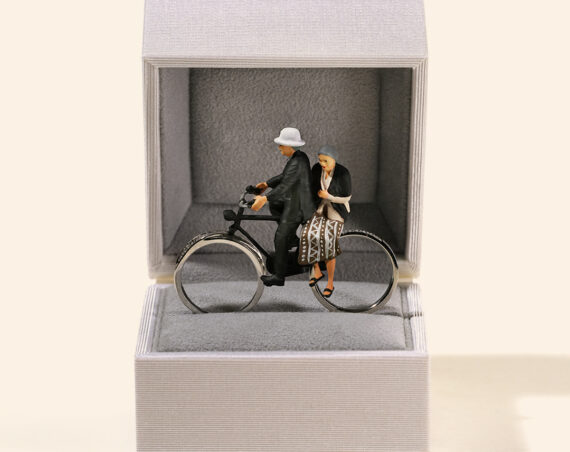Marisol Escobar, often known simply as Marisol, was a Venezuelan-American sculptor and artist who left an indelible mark on the art world with her unique blend of pop art and folk art styles. While she created many notable works throughout her career, today we’ll focus on one of her intriguing pieces depicting two bicycle riders.
The Artist: Marisol Escobar
Before we delve into the specific sculpture, let’s take a moment to appreciate the artist herself. Marisol Escobar (1930-2016) was born in Paris to Venezuelan parents and spent much of her life in New York City. Her work often combined woodcarving with found objects, creating assemblages that were both playful and thought-provoking.
Marisol’s art frequently explored themes of American society, family relationships, and her own identity. Her distinctive style, which blended elements of pre-Columbian folk art with contemporary pop art, set her apart from her peers and earned her significant recognition in the 1960s and beyond.
The Bicycle Riders Sculpture
One of Marisol’s lesser-known but fascinating works is her sculpture depicting two bicycle riders. This piece exemplifies her unique approach to capturing movement and human interaction in three-dimensional form.

Description of the Work
The sculpture features two figures on bicycles, likely carved from wood – Marisol’s preferred medium. True to her style, the figures are probably somewhat blocky and geometric, with simplified features that nonetheless convey a sense of personality and motion.
The bicycles themselves may be a combination of carved elements and found objects. Marisol was known for incorporating real-world items into her sculptures, so it’s possible that parts of actual bicycles were used in the creation of this piece.
Capturing Motion in Static Form
One of the most impressive aspects of this sculpture is likely its ability to convey a sense of movement despite being a static object. Marisol had a talent for suggesting motion through the positioning of her figures and the lines of her sculptures.
In this piece, we can imagine the slight lean of the riders’ bodies, the implied rotation of the bicycle wheels, and perhaps even a sense of wind created by the arrangement of the figures in space. All of these elements would come together to give the viewer a feeling of cyclists in motion, frozen in a moment of time.
The Social Aspect
Marisol’s work often commented on social interactions and relationships. The choice to depict two cyclists rather than a solo rider suggests a focus on companionship or shared experience. Are the riders racing each other? Enjoying a leisurely ride together? The viewer is invited to interpret the relationship between the two figures.
Conclusion
While this particular sculpture may not be as well-known as some of Marisol’s other works, it serves as an excellent example of her artistic style and thematic interests. By capturing the essence of bicycle riding – motion, balance, and social interaction – in a static sculpture, Marisol demonstrates her ability to distill complex experiences into compelling visual art.
As with much of Marisol’s work, this piece likely invites viewers to consider their own experiences and relationships, all while appreciating the unique blend of folk art simplicity and pop art boldness that characterized her remarkable career.



